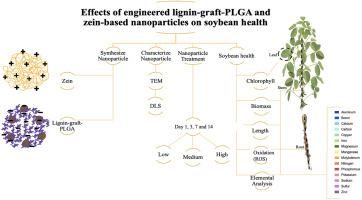NanoImpact ( IF 4.7 ) Pub Date : 2021-06-01 , DOI: 10.1016/j.impact.2021.100329 Fallon Salinas 1 , Carlos E Astete 1 , John H Waldvogel 1 , Sara Navarro 1 , Jason C White 2 , Wade Elmer 2 , Carlos Tamez 2 , Jeffrey A Davis 3 , Cristina M Sabliov 1

|
The majority of published research on the effect of engineered nanoparticles on terrestrial plant species is focused on inorganic nanoparticles, with the effects of organic polymeric nanoparticles (NP) on plants remaining largely unexplored. It is critical to understand the impact of polymeric NPs on plants if these particles are to be used as agrochemical delivery systems. This study investigates the effect of biodegradable polymeric lignin-based nanoparticles (LNPs) and zein nanoparticles (ZNP) on soybean plant health. The LNPs (114 ± 3.4 nm, −53.8 ± 6.9 mV) were synthesized by emulsion evaporation from lignin-graft-poly(lactic-co-glycolic) acid, and ZNPs (142 ± 3.9 nm and + 64.5 ± 4.7 mV) were synthesized by nanoprecipitation. Soybeans were grown hydroponically and treated with 0.02, 0.2, and 2 mg/ml of LNPs or ZNPs at 28 days after germination. Plants were harvested after 1, 3, 7 and 14 days of particle exposure and analyzed for root and stem length, chlorophyll concentration, dry biomass of roots and stem, nutrient uptake and plant ROS. Root and stem length, chlorophyll and stem biomass did not differ significantly between treatments and controls for LNPs-treated plants at all concentrations, and at low doses of ZNPs. At 2 mg/ml ZNPs, the highest concentration tested, after 7 days of treatment chlorophyll levels and root biomass increased and stem length was reduced in comparison to the control. Nutrient uptake was largely unaffected at 0.02 and 0.2 mg/ml NPs. A concentration-dependent increase in the oxidative stresss was detected, especially in the ZNP treated plants. Overall, LNPs and ZNPs had a minimum impact on soybean health especially at low and medium doses. To our knowledge this is the first study to show the effect of zein and lignin based polymeric NPs designed for agrochemical delivery on soybean plant health.
中文翻译:

工程化木质素接枝-PLGA 和玉米醇溶蛋白纳米颗粒对大豆健康的影响
大多数已发表的关于工程纳米颗粒对陆地植物物种影响的研究都集中在无机纳米颗粒上,而有机聚合物纳米颗粒(NP)对植物的影响基本上尚未被探索。如果要将这些颗粒用作农用化学品输送系统,那么了解聚合物纳米颗粒对植物的影响至关重要。本研究研究了可生物降解的聚合木质素纳米颗粒(LNP)和玉米醇溶蛋白纳米颗粒(ZNP)对大豆植物健康的影响。 LNPs(114±3.4 nm,-53.8±6.9 mV)是通过木质素接枝聚(乳酸-乙醇)酸乳液蒸发合成的,ZNPs(142±3.9 nm和+64.5±4.7 mV)是合成的通过纳米沉淀。大豆采用水培法生长,并在发芽后 28 天用 0.02、0.2 和 2 mg/ml LNP 或 ZNP 处理。颗粒暴露 1、3、7 和 14 天后收获植物,并分析根和茎长度、叶绿素浓度、根和茎干生物量、养分吸收和植物活性氧。在所有浓度和低剂量的 ZNP 下,经 LNP 处理的植物的根和茎长度、叶绿素和茎生物量在处理和对照之间没有显着差异。在 2 mg/ml ZNP(测试的最高浓度)下,处理 7 天后,与对照相比,叶绿素水平和根生物量增加,茎长度减少。 0.02 和 0.2 mg/ml NP 时,养分吸收基本不受影响。检测到氧化应激呈浓度依赖性增加,特别是在 ZNP 处理的植物中。总体而言,LNP 和 ZNP 对大豆健康的影响最小,特别是在低剂量和中剂量时。 据我们所知,这是第一项研究显示基于玉米醇溶蛋白和木质素的聚合物纳米粒子设计用于农用化学品输送对大豆植物健康的影响。











































 京公网安备 11010802027423号
京公网安备 11010802027423号